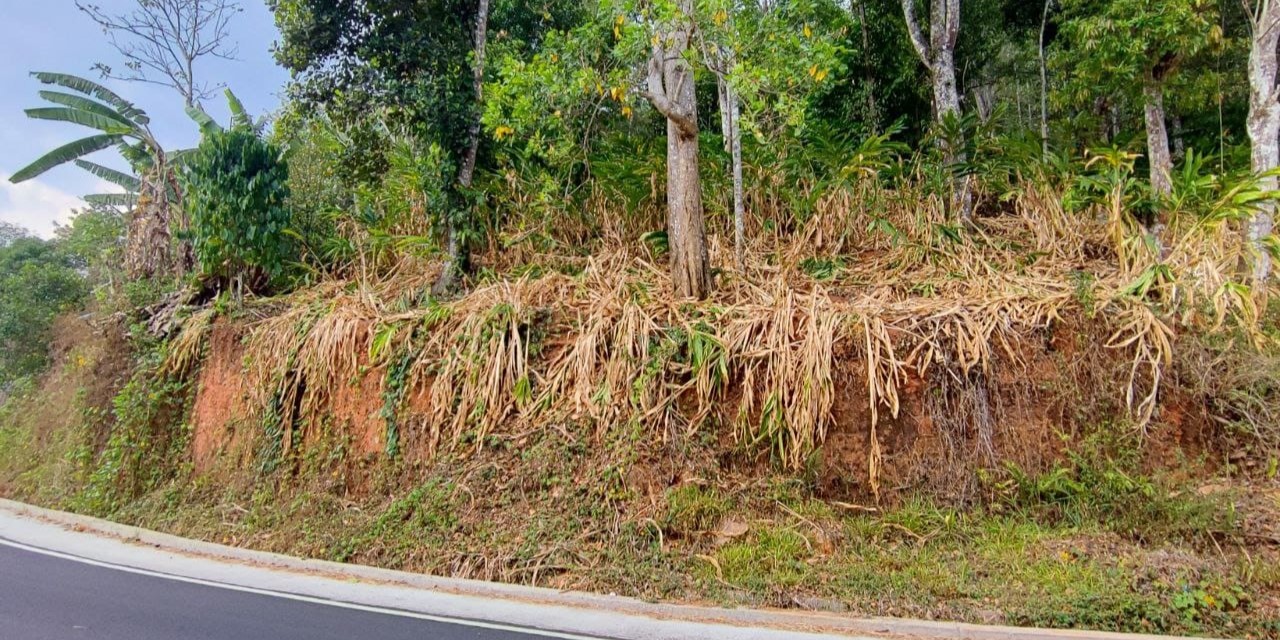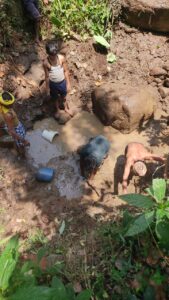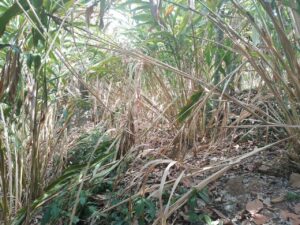In Kerala, farmers in general are bearing the brunt as they fear that the soaring temperatures may disrupt agricultural practices and jeopardize their livelihoods.

Damaged cardamom crops
In Kerala, the relentless sun beating down mercilessly has become a new normal. In many places, it turned the once lush greenery spaces into a weary shade of brown.
As the mercury rises to unprecedented levels, farmers in general, are bearing the brunt as they fear that the soaring temperatures may disrupt agricultural practices and jeopardize their livelihoods.
For those in the high ranges, like the cardamom and coffee growers of Idukki and Wayanad, the unforgiving sun was a particularly harsh visitor, disrupting crops and thereby shattering their dreams.

Cardamom crop damaged because of the heat
Talking to South First, Fedin Mathew a cardamom farmer in Idukki said that it was last December that they got rains.
“The heat is unforgiving. Our cardamom plants are struggling to cope. The flowering patterns are disrupted, and the yields are dwindling. This year cardamom production will slump,” said Fedin.
According to him, 70 percent of the cardamom plantations in the district are affected because of the heat, and 90 percent of the crops are damaged.

Cardamom farmers sourcing water
Cardamom, called the ‘Queen of Spices’, is an important spice crop cultivated in Kerala. Even though cardamom is cultivated only in seven districts in Kerala, it occupies about 15.82 percent area under the cultivation of spices and condiments and has the third largest area among them.
For the year 2021-22, the total area of cardamom cultivation was 39,143 Ha. Major cultivation of cardamom is in the Idukki district and the contribution to the total area is 79.90 percent.
“The small-scale producers of cardamom are the worst affected as there is no water. The plantations managed by corporate companies have now pressed the service of water tankers,” added Fedin.
He also pointed out that for a cardamom farmer, light rain will do more damage than good and they are expecting heavy rain which could save their crops.
“The dairy farmers are another category who are affected by this heat. The authorities should do something to help us recover from this crisis,” said Fedin.

Damaged cardamom crops
Another cardamom farmer, Kriss Kuriakose told South First that an alarming sight unfolds in the district as cardamom plants, once a symbol of abundance, are now drying up and falling, succumbing to the relentless heat.
“For a cardamom plant to flower, we need a temperature between 18 to 23 degrees Celsius. But we are now getting 35 to 38 degrees Celsius. There is widespread crop loss. We estimate that 50 percent of the cardamom cultivation has been destroyed in the district,” said Kriss.
He also added that, to make matters worse, the farmers are facing water depletion.
“Many farmers are now trying to save those cardamom crops which are comparatively healthy. The water bodies are drying up and we don’t know what to do,” added Kriss.
“The distress is palpable and the spectre of farmer suicides looms large on the district,” John Namala, a farmer in Wayanad told South First.
He then added, “While the scorching sun takes its toll on crops, exacerbating the challenges faced by farmers, another pressing issue compounds their distress – the acute shortage of water.”
According to him, as streams run dry and wells deplete, coffee cultivators find themselves grappling with a dire predicament that threatens not only their livelihoods but also the very survival of their cherished crops.
“The most affected area is Pulpally where coffee plants dried up. The plight is not limited to coffee cultivators. Every farmer is bearing the brunt of the heat. Many of my friends told me that suicide is the only option for them. The situation is tense here,” added John.
Coffee is one of the important plantation crops in Kerala and the area of cultivation during 2021-22 is 85,880 Ha with Wayanad district standing first with an area of 67,705 Ha.
Talking to South First, Paul Mathews, a coffee grower in Wayanad said that while two rains are needed for coffee plants, many farmers received only one and are waiting for the other.
“Coffee is a water-intensive crop and it majorly depends on two rains. The first rain is for flowering. After one week another rain is required, which we call back-up rain, as it will strengthen the coffee plant. But with the second rain yet to arrive, the possibility of crop loss is high,” said Paul.
Another problem is that the coffee growers are not able to apply fertilizers as the soil is not that wet.
As the state swelters under the scorching sun, the state’s dairy and poultry farmers brace themselves for the impact of rising temperatures on their livelihoods.
They said a looming crisis unfolds as the heatwave intensifies, threatening to disrupt their livelihoods. From dairy cows struggling to cope with heat stress to poultry birds facing increased mortality rates, the challenges ahead for these farmers are daunting.
“Poultry farmers usually avoid this time for hatching as mortality among chicks will be high due to the heat. Those who engage in the same normally reduce the number of chicks in their hatchery. That is, if a farmer plans to hatch 100 chicks, only 50 will survive,” M Thajudeen, state president of All Kerala Poultry Federation told South First.
In the case of dairy farmers, the heat stress is said to have affected milk yields. Many farmers complain that the heat has reduced milk production, impaired reproductive performance, and increased susceptibility to diseases among dairy cows.
Paddy cultivation has also been affected in many regions as water levels in reservoirs and irrigation channels have plummeted to alarming lows, forcing farmers to ration water usage.
Traditional paddy cultivation relies heavily on irrigation systems fed by rivers, canals, and rainfall. However, as water sources dwindle and evaporation rates soar in the blistering heat, farmers are struggling to meet the water demands of their crops.
Paddy is the principal crop extensively cultivated in all the districts of the state having a unique three-season pattern viz Autumn (July- October), Winter (November –February), and Summer (March – June).
According to Kerala Independent Farmers’ Association chairman Alex Ozhukayil, it is high time that the state announced drought and rolled out compensation schemes for farmers.
“The state should immediately announce drought. The northern part of the state is rain-deprived. It has been more than three months since many parts of the state received rainfall. There is no point in delaying the announcement that the state is drought hit,” said Alex to South First.
According to the Kerala State Disaster Management Authority, drought is a recurring extreme climate event over land characterized by below-normal precipitation over months to years.
It also said that as per the Drought Manual 2016, the declaration of drought should satisfy any of the five categories of indices for developing a monitoring matrix for drought.
The five categories of indices are Rainfall, Vegetation, Water, Crop, and others. Rainfall is considered to be the most important indicator and therefore related meteorological data should be mandatorily considered in making any assessment of drought.
At the same time, a senior official of the Department of Agriculture Development and Farmers Welfare told South First that the department would assess the crop damage.
“There is definitely a drought-like situation in the state and crop losses are being widely reported. We will assess that and will do the needful,” said the officer.
(Edited by Shauqueen Mizaj)

Jul 26, 2024

Jul 26, 2024

Jul 25, 2024

Jul 25, 2024

Jul 25, 2024

Jul 24, 2024